In case you are wondering why on earth I am sewing 18th century underwear, let me give a bit of backstory. I love making costumes (see my last Halloween costume), and I have done a bit of cosplay in the past. I have also thought that it might be fun to get into historical costuming, because, while I would never want to live in the past given how women were treated (and how hard life was in general), some of the dresses were totally amazing. And that’s the great thing about sewing, right? I can make anything I want!
This costume is actually going to be both cosplay and historical. How is that possible you ask? Well, I am an Outlander fan, and so I am making one of the dresses the heroine wears on the show. For the unaware, Outlander is about a woman from the 1940’s named Claire who time travels back to the 1740’s in the highlands of Scotland. (The TV show is based on the novels by Diana Galbadon.) Outlander has actually done a great job making the costumes historically accurate (as historically accurate as it is possible to be given constraints such as budget, time, etc.). (For those who are interested, there is much discussion of the Outlander costumes from a historical perspective on frockflicks.) The costume designer for Outlander, Terry Dresbach, has a wonderful blog where she writes about her design choices and posts detailed pictures of the garments. I will be making “the” red dress, which is actually one of the less historical dresses. However, I am not directly copying the show. Instead, I’m using a historical pattern that is similar and making it in red. I figure that way it can double as both cosplay and historical costuming.
 |
| I’m only showing the back of the first cause the front was a bit scandalous for the internet. |
In addition, I am taking advantage of the fact that this is my very first Halloween that I will get to spend with my beloved. Which means we are doing couples costumes!! He is super excited graciously agreeing to be Claire’s love interest Jamie! Which means I will be making not only a compete 18th woman’s ensemble, but also one for an 18th century man. A total of 9 garments! As this is my first historical sewing (except for my Victorian corset), I simplified things and ordered the complete pattern packages for 18th century lady and gentlemen from Reconstructing History.
 |
| Note the historically correct spiral rather than criss-cross lacing. |
 |
| Those tabs were super-annoying to sew– the only way I could do them was by hand. |
In keeping with the historical theme, I’m making all of the necessary underpinnings. The first of these is of course the shift. In this time period, the shift was the first layer. Shifts were made of linen, as cotton was generally very expensive or unavailable. Shifts were worn by people of all classes, with the rich using finer linen than the lower classes. Since the outer dress would not have been washed very frequently, one job of the shift was to provide a layer between the body and the outer garment. For men, the equilvalant of the shift was the shirt, which was actually a very similar garment. The shirt has a collar, longer sleeves, and is shorter, while the shift is longer and has gores to make a wider skirt. But overall their shape was very similar, and they had the same function.
| My flat-felled seam. |
| Arm gusset. |
My shift (and Wade’s shirt) is fairly accurate in that it is made from linen. Constructing the shift and the shirt definitely felt different from constructing a modern garment. All of the pieces were either rectangles or triangles, with the exception of the neckline. They were cut this way to make the most economical use of the fabric. I have read posts from some historical costumers who hand sew their shifts, and they impress me with their dedication, but there was no way I was doing that. I used my machine, but did use felled seams for all the main seams. I was seriously temped to serge the arm gussets, but it just felt wrong on such a historical-feeling pattern. Instead, I cut a second gusset piece and handstitched it over. I have no idea if it was ever done like that, but I couldn’t leave all those raw edges.
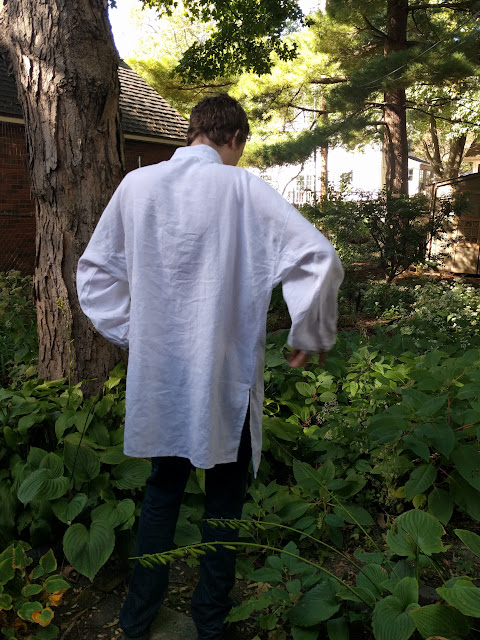 |
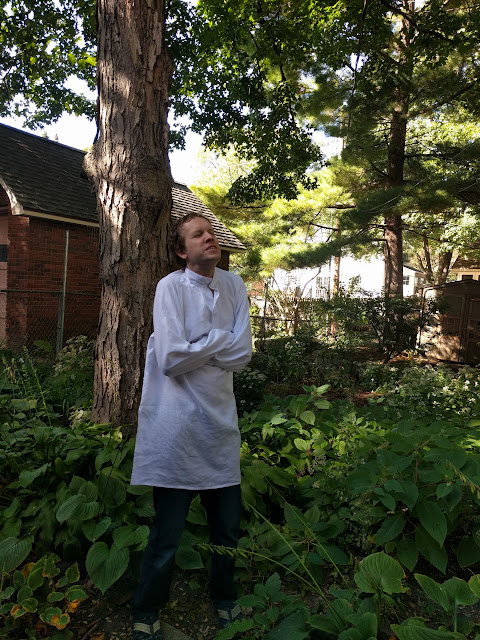 |
| Pretty sure this expression represents his true feelings about being made to wear an 18th century undergarment in pictures. |
For me, the undergarments also include a corset (called stays in the 18th century), and something to support the skirt. The stays are the bust support, and also help to support the weight of the dress. Unlike Victorian and later corsets, 18th century stays are not designed to create an hourglass silhouette. Instead, they are intended to create a funnel or cone shape. My stays are made out of a stiff herringbone cotton twill that was not sold as coutil but seems pretty similar. This is not historically accurate, but it will function perfectly and I already had it in my stash. I have lined the corset with the same linen I used for my shift. My outer fashion fabric is a dupioni silk that I had leftover from another project. I didn’t wan’t to buy anything for the stays, and this was the only fabric that was sturdy enough and I had enough of. Although silk is an accurate fiber, the dupioni weave is actually a modern type of fabric. My stays are only half-boned. Completely boned stays are essentially all boning, with each rib lying right next to each other. For boning, I used plastic cable ties. Historically, whale bone (actually baleen, not bone) or sometimes reeds would have been used. Obviously, whale bone is no longer an option. In reading about reproducing 18th century stays, I learned that spiral steel (the modern material of choice for most corsets) does not accurately reproduce the qualities of whalebone. While reeds can be obtained, they are hard to find and tricky to use. Therefore, it seems that most costumers opt to use plastic.
 |
| I did not set out to copy the pattern photo, but I kinda did. |
To finish the stays, the edges must be bound. I opted not to use my blue silk because I thought a contrast border would be cute. Afterwards, I realized that my choice may have been influenced by the model cover photo on the pattern. I did not want to waste my linen making binding, so instead I used some white quilting cotton that I had lying around. I quickly learned that binding all those little tabs on 18th century stays is a pain in the ass. I first tried using my machine, but quickly learned that was impossible. I was able to attach the binding to the straighter parts by machine, which I then finished by slipstitching. The tabs, however, I had to stitch entirely by hand; first using a running stitch to attach the binding, then finishing with the slipstitching. I am not used to doing that much handsewing, and I was contending with 4 layers of fabric. When I finally finished, my hands were sore for several days afterwards. The inside of the binding is not perfectly smooth, but I am just glad it is done. I am pretty happy with my stays aside from the size. I made a mock-up in posterboard as suggested by the pattern, but it proved hard to fit. The overall fit of my stays is actually pretty good, but instead of have a two inch gap in the back, it has to be laced all the way down. This seems to be a pattern with me and corsets.
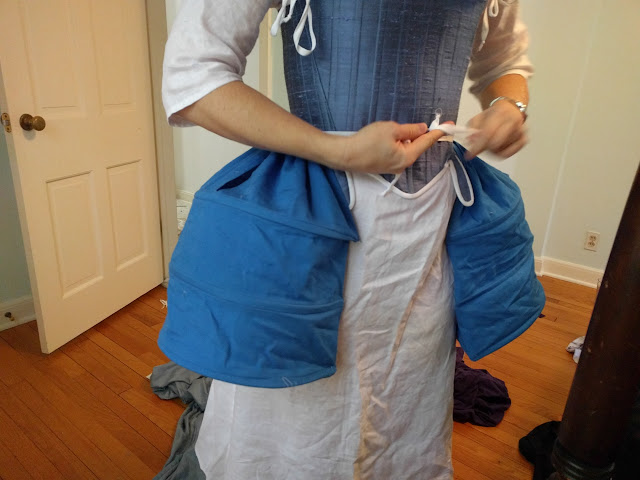 |
| Putting on my pocket hoops. |
The 18th century silhouette has a wide skirt that protrudes from the hips. To support this shape, some type of structure has to be used. Sometimes, boning was just added to a petticoat. Sometimes a full-length cage was used. I am using what are called pocket hoops, which are somewhere in the middle. And just like the name suggests, they actually do double as pockets. Once again, everything for the hoops are from my stash. The blue is some cotton canvas I bought ages ago, and I used the same spiral steel I used for my Victorian corset to give it structure.
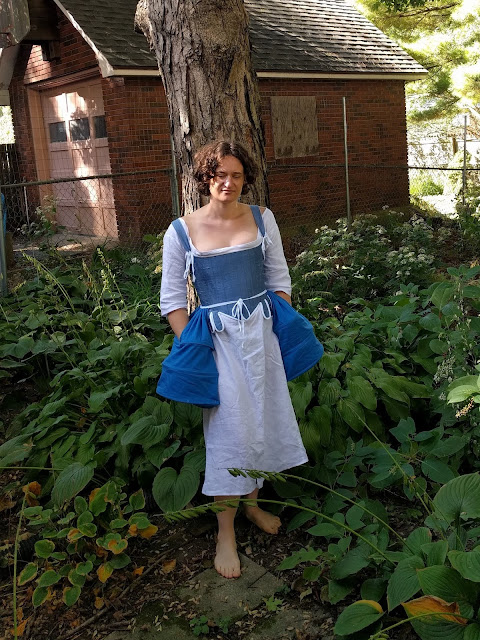 |
| Pocket hoops are actually pockets! |
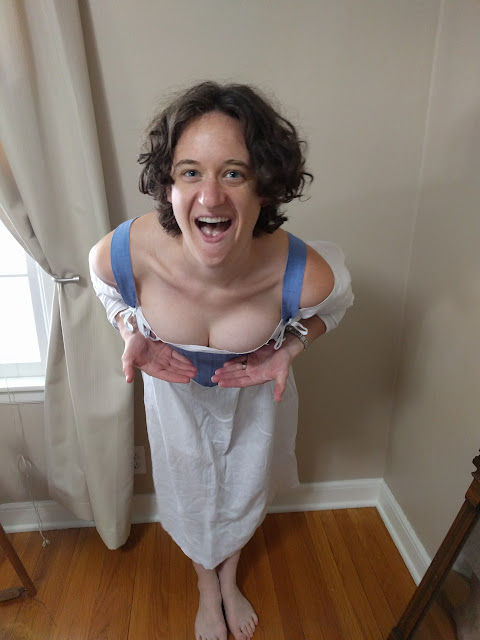 |
| Me explaining to Wade that the goal was to have your boobs look like “apples on a platter”. |
 |
| Wade approves! |


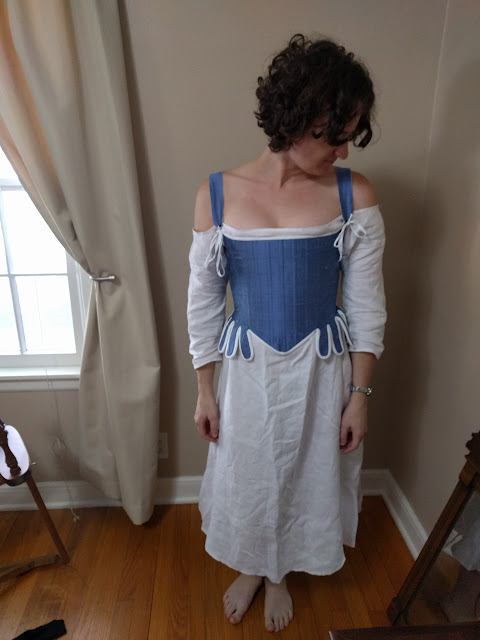
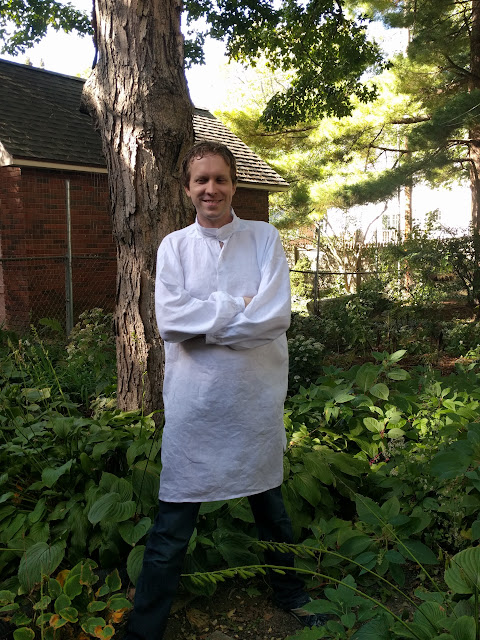
Very lovely!
Thanks!